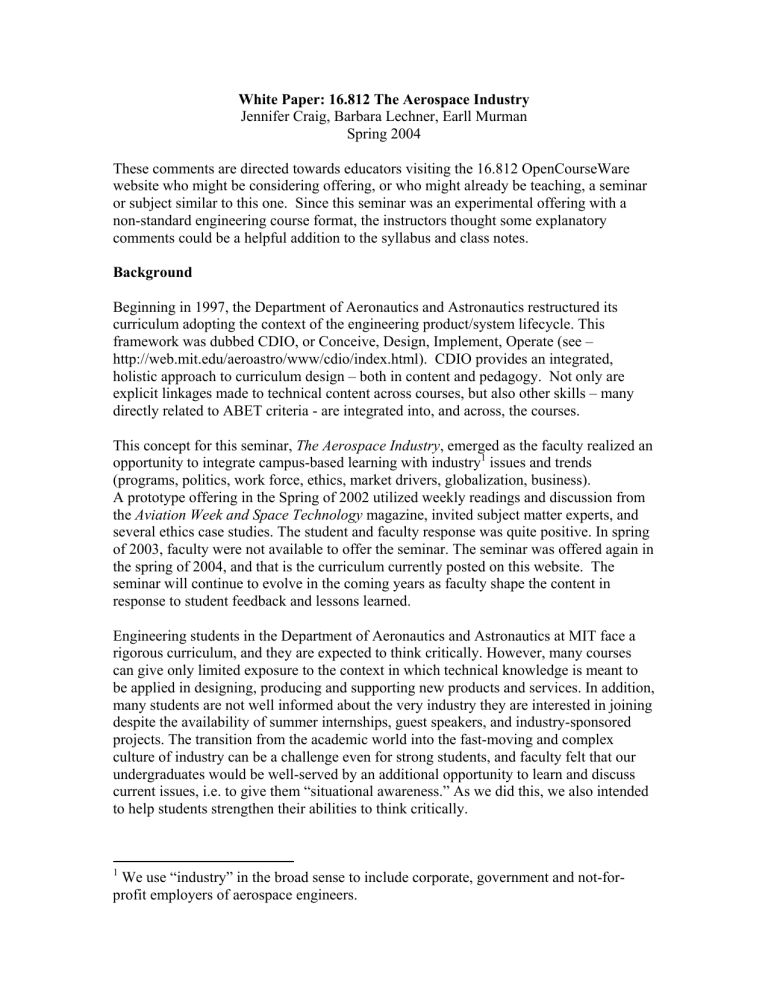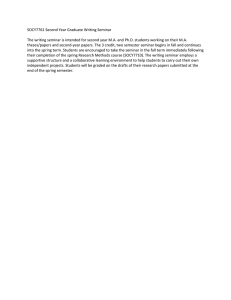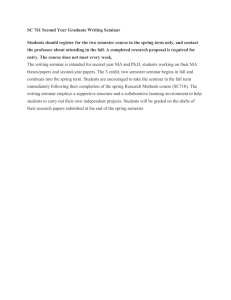White Paper: 16.812 The Aerospace Industry Spring 2004

White Paper: 16.812 The Aerospace Industry
Jennifer Craig, Barbara Lechner, Earll Murman
Spring 2004
These comments are directed towards educators visiting the 16.812 OpenCourseWare website who might be considering offering, or who might already be teaching, a seminar or subject similar to this one. Since this seminar was an experimental offering with a non-standard engineering course format, the instructors thought some explanatory comments could be a helpful addition to the syllabus and class notes.
Background
Beginning in 1997, the Department of Aeronautics and Astronautics restructured its curriculum adopting the context of the engineering product/system lifecycle. This framework was dubbed CDIO, or Conceive, Design, Implement, Operate (see – http://web.mit.edu/aeroastro/www/cdio/index.html). CDIO provides an integrated, holistic approach to curriculum design – both in content and pedagogy. Not only are explicit linkages made to technical content across courses, but also other skills – many directly related to ABET criteria - are integrated into, and across, the courses.
This concept for this seminar, The Aerospace Industry , emerged as the faculty realized an opportunity to integrate campus-based learning with industry 1 issues and trends
(programs, politics, work force, ethics, market drivers, globalization, business).
A prototype offering in the Spring of 2002 utilized weekly readings and discussion from the Aviation Week and Space Technology magazine, invited subject matter experts, and several ethics case studies. The student and faculty response was quite positive. In spring of 2003, faculty were not available to offer the seminar. The seminar was offered again in the spring of 2004, and that is the curriculum currently posted on this website. The seminar will continue to evolve in the coming years as faculty shape the content in response to student feedback and lessons learned.
Engineering students in the Department of Aeronautics and Astronautics at MIT face a rigorous curriculum, and they are expected to think critically. However, many courses can give only limited exposure to the context in which technical knowledge is meant to be applied in designing, producing and supporting new products and services. In addition, many students are not well informed about the very industry they are interested in joining despite the availability of summer internships, guest speakers, and industry-sponsored projects. The transition from the academic world into the fast-moving and complex culture of industry can be a challenge even for strong students, and faculty felt that our undergraduates would be well-served by an additional opportunity to learn and discuss current issues, i.e. to give them “situational awareness.” As we did this, we also intended to help students strengthen their abilities to think critically.
1 We use “industry” in the broad sense to include corporate, government and not-forprofit employers of aerospace engineers.
Seminar Format
Each week in The Aerospace Industry , students read chapters from Lean Enterprise
Value: Insights from MIT’s Lean Aerospace Initiative and several articles chosen from the current issue o f Aviation Week & Space Technology in preparation for a two-hour class discussion . Class meetings often included short presentations from the seminar faculty as well as invited academic and industry specialists. The seminar faculty decided on a pedagogical strategy that used active learning and small group discussions to keep the class discussion and debate lively and focused. Several formats were tried during the semester, each providing interesting results. A few notes are given here to help navigate through the website postings for the different classes.
- In the first class, students were presented with a short industry press release regarding two senior executives who had been dismissed for ethics transgressions.
Students were asked to read the press release, discuss it critically in small groups, and then participate in a class discussion with prompts from the faculty. For most students, this was the first time they had read a carefully crafted press release where every word and sentence was carefully chosen to state the company’s position on a delicate matter.
- In classes 2-4, students were asked to develop discussion questions as they read the weekly assignments, and in particular to look for linkages between the mostly historical information in Part I of Lean Enterprise Value: Insights from MIT’s
Lean Aerospace Initiative with the current events from Aviation Week & Space
Technology . The small group sessions followed by full class discussion engaged the students, but not nearly as well as the formats offered below. As there were no prepared faculty remarks for these classes, there are no postings on the web site.
- Class 5 involved a debate format with the class divided into four teams: pro and con presenters and rebutters. This was one of the most successful formats for engaging the students.
- Classes 6 and 7 used faculty-facilitated discussions. Some involved small groups with group reports, while others engaged the entire class.
- In class 8, the students were formed into teams to advise a former senior executive on a policy question: should he contract with a start up company for satellite launch services, or stay with established sources? An Aviation Week &
Space Technology article and the guest’s former industry position where he had made many such decisions prompted this. This role-playing approach was very effective in engaging the students.
- One of the guests in class 9 was a Wall Street aerospace analyst and an unstructured question and answer session proved effective. Most students had no previous insights into Wall Street, and how analysts follow technology development and market opportunities.
- In the final class 10, students developed arguments as to what value the US taxpayer would get from sending humans to Mars. The guest speaker then responded to each point showing the strength and weaknesses of the arguments.
Another important aspect of the class format was student journals, informed by the readings and class discussion. Students wrote weekly journal entries of approximately
400 words, or about 10 pages during the entire term. The journal entries allowed us to assess each student’s insights into the subject matter of the course as well as the level of effort. They were an important part of judging the degree of critical thinking, covered in the next section.
At the end of the semester, each student met with faculty for an interview in which s/he was asked to talk about her/his professional goals in the aerospace industry.
Developing Skills for Critical Thinking
To our way of thinking, advanced critical thinking skills---sometimes referred to as higher order skills---are central to sophisticated engineering design problems, to systems thinking, to interpersonal and team situations, and to addressing subtle and complex ethical problems. In repeated instances, we hear industry partners ask for engineers who are “ready for the workplace,” and we think that this request does not refer simply to young professionals well-educated in the technical spheres but also to engineers who are able to think their ways through new and unexpected challenges. However, we did not have any evidence to assure us that students could think critically at the higher levels.
We could see that they were able to summarize, understand and apply new knowledge.
But could they analyze complex situations, create new solutions from various perspectives or evaluate? We wanted to be sure that they could.
Journaling in academic settings can be useful in assessing student insight, but it also can result in flabby, superficial prose. We did not want our students to practice poor writing habits nor did we want to turn the journaling into rigorous essay writing. Thus we based much of our prompting for journal entries on critical thinking skills (Table 1).
In order to clarify our methods for the students, we briefly reviewed critical thinking skills. Although there are a number of models for critical thinking, our faculty used
Bloom’s Taxonomy of critical thinking skills: knowledge, comprehension, application, analysis, synthesis and evaluation.
Discussions in the seminar were always lively and substantive. We believed that much of this liveliness was due to the rich and engaging material (text, current periodical, speakers) and the pedagogy (active learning, discussion, small group interaction). But what interested our faculty as the semester progressed was the substance of many of the discussions in which students tackled complex, sophisticated issues. Initially, we planned
Table 1: Journal prompts for The Aerospace Industry seminar
For reflection on a person For reflection on an event For reflection on an issue
• What seemed to be the formative events in this
• Could I summarize this event and what led up to it
• Could I summarize both sides of this issue for a less person’s life and/or career? for a peer? Could I summarize it for someone informed audience?
• Were there decision points that focused his/her work in one direction rather than another?
• What do I know about this person’s ethical point of view? Behavior? Do I agree? Not agree? If I don’t know this, what do I imagine s/he has had to face making ethical choices about?
• What do I find appealing or admirable about this person? Or what do I find not so appealing, not so admirable?
• Does this person remind me of anyone I’ve known or read about? younger and less informed than I?
• What were key events that led to this event?
• What events did this event precipitate?
• What unintended consequences may have been brought about by this?
• Will this event change history for the better? For the worse?
• How do I feel about this issue? And now, what is the argument for an opposite point of view?
• What is the relevance of this issue to me and to my life/career?
• What other issues are connected to this issue?
• If I were to resolve this issue, what steps would I recommend be taken?
• As I think about this issue and listen to others discuss it, what values do I hear expressed? What are my values that help form my opinion?
• What about this person would I emulate? Not emulate? that journal writing would inform the discussion, but it seemed clear as we went through the semester that the journals often were written after the class discussion. Moreover, when we reviewed the journals at three points in the semester, we noted that many of the journal entries were less sophisticated than the discussions. Often, the entries were summaries of readings and individual responses rather than a demonstration of higher order critical thinking skills.
It is possible that journals served as a way for less extroverted students to articulate their thoughts and, in some cases, as places for students to develop an idea more thoroughly or
personally. Perhaps the more likely stimuli for the discussions were the reflective and substantive exchanges modeled by faculty members between themselves and with the guest speakers.
Seminar Assessment
The end of semester on-line student evaluation contained several questions to ascertain the student’s achievement of some skills addressed in the seminar, in addition to standard questions about course and faculty effectiveness. Seven of the seventeen students replied using a scoring system of 0 = not at all, 1 = moderately, 2 = significantly, to evaluate the effectiveness of the seminar for aiding student learning on each topic. Results shown in
Table 2, although only for less than 50% of the class, generally show positive outcomes.
In addition, the students were very enthusiastic about the seminar, often expressing how the material positively complemented the core engineering content of the curriculum.
Table 2. Student assessment of seminar
Question: To what extent did this seminar teach you to:
Recognize the influence of new technology on society?
Evaluate ideas from a variety of perspectives?
Evaluate professional journals and industry news?
Recognize the importance of having a global perspective?
Reflect on political, social, legal and environmental issues and values important to the engineering field?
Recognize the interrelationship among business, economics, technology, education, politics and industry?
Appreciate different enterprise cultures (e.g. large v small, market v policy driven, mature v entrepreneurial) and the way that differences influence the business of engineering?
Recognize situations in the workplace with conflicting ethical imperatives?
Recognize the importance of being current in your field and the need for life-long learning?
Articulate your own career plans?
Score
1.71
1.71
1.86
1.86
1.71
2
1.71
1.29
1.86
1.43
Conclusion
The Aerospace Industry seminar proved to be well received by students in the course as well as visiting faculty and speakers. We accomplished our learning objectives in that students clearly were informed about not only the recent history but also current events in the aerospace industry. They were better able to appreciate value creation in aerospace programs, and they demonstrated ability to use critical thinking to explore issues within the industry. In exit interviews, students were easily able to discuss their career interests knowledgeably.
In future seminars, we’ll maintain our emphasis on small group work and active learning while continuing to explore the pedagogy of teaching higher order critical thinking skills.


